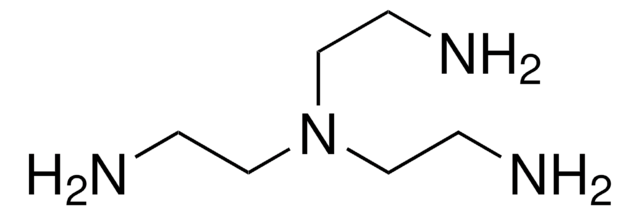Kluczowe dokumenty
85610
Spermine tetrahydrochloride
≥99.0% (AT), powder or crystals
Synonim(y):
N,N′-Bis(3-aminopropyl)-1,4-butanediamine tetrahydrochloride
About This Item
Polecane produkty
pochodzenie biologiczne
microbial
synthetic
Poziom jakości
Próba
≥99.0% (AT)
Formularz
powder or crystals
mp
310-311 °C (dec.) (lit.)
rozpuszczalność
H2O: 0.1 g/mL, clear
temp. przechowywania
room temp
ciąg SMILES
Cl.Cl.Cl.Cl.NCCCNCCCCNCCCN
InChI
1S/C10H26N4.4ClH/c11-5-3-9-13-7-1-2-8-14-10-4-6-12;;;;/h13-14H,1-12H2;4*1H
Klucz InChI
XLDKUDAXZWHPFH-UHFFFAOYSA-N
Szukasz podobnych produktów? Odwiedź Przewodnik dotyczący porównywania produktów
Zastosowanie
Działania biochem./fizjol.
Hasło ostrzegawcze
Warning
Zwroty wskazujące rodzaj zagrożenia
Zwroty wskazujące środki ostrożności
Klasyfikacja zagrożeń
Eye Irrit. 2 - Skin Irrit. 2
Kod klasy składowania
11 - Combustible Solids
Klasa zagrożenia wodnego (WGK)
WGK 3
Temperatura zapłonu (°F)
Not applicable
Temperatura zapłonu (°C)
Not applicable
Środki ochrony indywidualnej
dust mask type N95 (US), Eyeshields, Gloves
Wybierz jedną z najnowszych wersji:
Masz już ten produkt?
Dokumenty związane z niedawno zakupionymi produktami zostały zamieszczone w Bibliotece dokumentów.
Klienci oglądali również te produkty
Nasz zespół naukowców ma doświadczenie we wszystkich obszarach badań, w tym w naukach przyrodniczych, materiałoznawstwie, syntezie chemicznej, chromatografii, analityce i wielu innych dziedzinach.
Skontaktuj się z zespołem ds. pomocy technicznej






